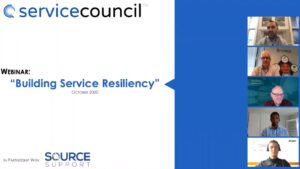Part 2: Ensuring Positive, Predictable Outcomes
In our last post, Mike Stolz described what makes up a resilient services framework and how to build such a network for your organization. Having held service leadership positions at multiple OEM organizations throughout my career (and now with Source Support), I can say from experience that service resiliency provides a monumental advantage when it comes to having the ability to meet or exceed customer and end-user expectations, regardless of whatever service disruptions or delays might present themselves along the way.
As any services leader will tell you, disruption can take many forms and often appears in unexpected ways and at inconvenient times. Field engineers get sick. Severe weather conditions reduce travel and shipping capabilities. A local city marathon or presidential visit shuts down roadways and causes severe traffic delays. A global pandemic leads many countries to implement travel restrictions, curfews, and social distancing orders. Managing disruptions like these on a case-by-case basis is not sustainable and will often lead to frustration, stress, and less-than-stellar service quality.
You know your business. You know what service events are most likely to come along and then what efforts will produce optimal results in terms of resolution and customer satisfaction. By implementing processes and standardizing your workflows to achieve these situations as much as possible, you will optimize your customer satisfaction and maximize the bandwidth your organization must work through other situations that come along. Obviously, both are critical to service success.
I’d like to build on the resilient services framework Mike described and draw out ways that service organizations can ensure predictable, positive outcomes by leveraging a robust services framework.
So how do you drive toward predictable, positive outcomes throughout your service delivery chain? Here are some ways:
- Attracting and retaining the right people. It all comes back to having the right skills and talents in your employees and field service workforce – and underlying that with the right culture and core values to support them and keep them fulfilled. Consistency of results, and ability to roll with the punches, requires steadiness in the people doing the work.
- Eliminating silos and barriers to these outcomes within your organization. For example, get rid of unnecessary, inefficient steps in processes and ensure people aren’t bogged down from delays in communication with others.
- Enable team members for success. Helping team members clearly understand the organization’s core values and behavioral expectations, means they can more easily make the right decisions to deliver positive customer experiences. The more you equip your teams with the right skills and processes, and the more you incent them to handle their business properly, the more efficiently things get done and the higher quality work they perform.
True resiliency in your service network means delivering positive outcomes no matter what challenges or obstacles might come along. We usually don’t know how our processes and systems are vulnerable until it’s too late, so being proactive in thinking and preparing for this across your organization is an essential part of delivering quality, consistent service and everyone in the organization has a role to play.
In the third and final post in this series, Eric Lomascolo will discuss what he sees coming in the months ahead that you’ll need to think about and react to in order to ensure your organization can build and maintain a resilient service network.
Discover More from Source:
Want to continue exploring this subject? Watch our latest webinar “Building Service Resiliency”.



